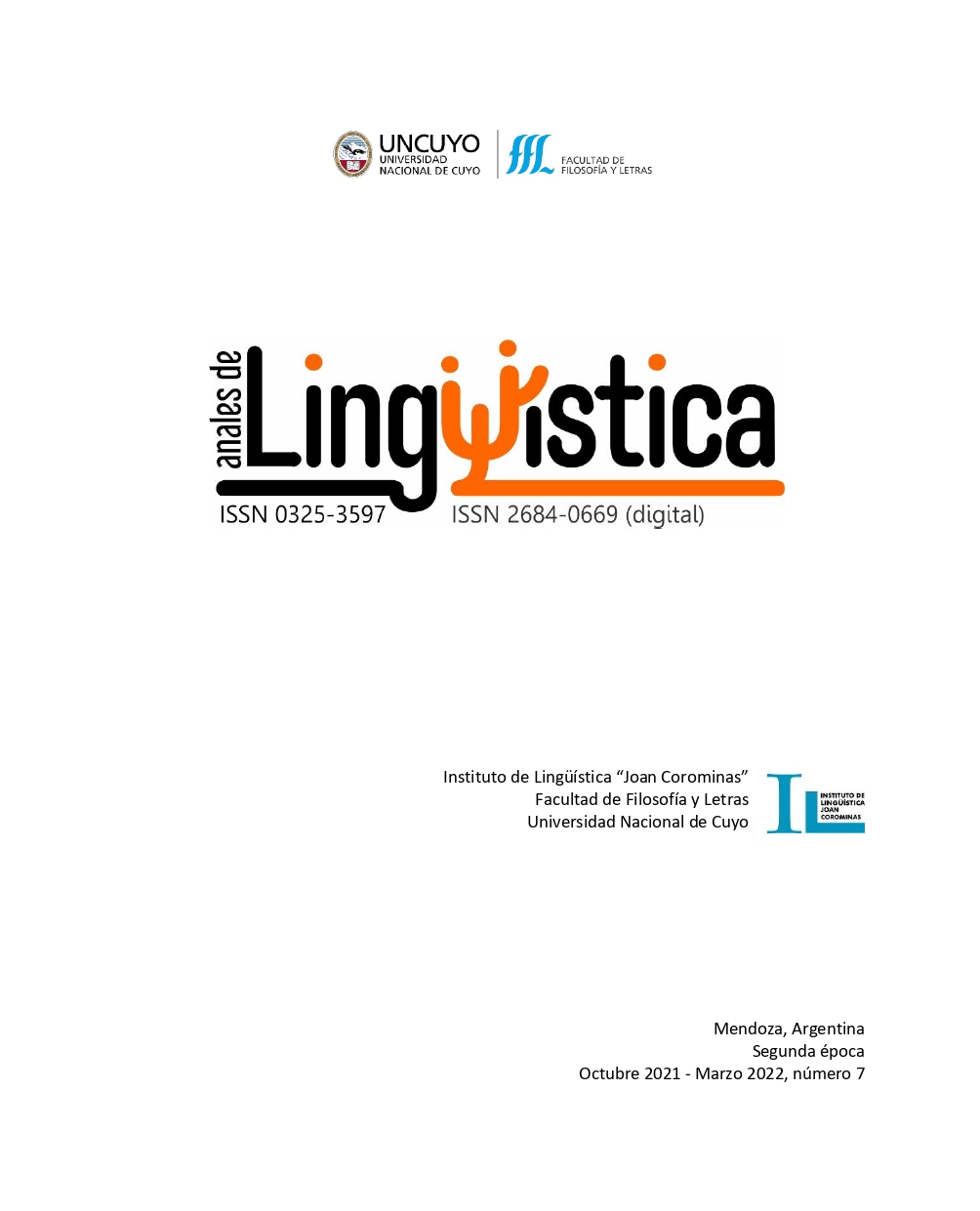Análisis de rasgos lingüísticos con técnicas de procesamiento del lenguaje natural en la detección temprana de depresión
Palabras clave:
detección temprana de depresión, representación de documentos, , incrustaciones de palabras, métrica ERDEResumen
El desarrollo de métodos computacionales que utilizan información de la Web para la detección temprana de riesgos es un área de investigación socialmente relevante, científicamente atractiva y actualmente en pleno crecimiento. La depresión es uno de los trastornos mentales más frecuentes a nivel mundial y con alta incidencia de suicidio en los casos más severos. Por lo tanto, su detección temprana podría derivar en un tratamiento a tiempo e incluso salvar vidas. En este trabajo, se analiza la relación que existe entre los modelos computacionales que permiten la detección automática de depresión y las propiedades lingüísticas del texto escrito por personas que experimentan la enfermedad. Se utilizan representaciones textuales que forman parte del estado del arte en clasificación de documentos y que cubren aspectos lingüísticos, sintácticos y semánticos. Los resultados obtenidos con clasificadores estándares indican que las incrustaciones de palabras capturan información precisa para detectar indicios de depresión de forma rápida y segura.
Citas
Acosta-Hernández M. E. et al. (2011). Depresión en la infancia y adolescencia: enfermedad de nuestro tiempo. Archivos de Neurociencia, 16(3), 156–161.
Al-Mosaiwi M. y Johnstone T. (2018). In an Absolute State: Elevated Use of Absolutist Words Is a Marker Specific to Anxiety, Depression, and Suicidal Ideation. Clinical Psychological Science, 6(4), 529–542.
Boston University School of Medicine. (2 de septiembre de 2020). COVID-19 has likely tripled depression rate, study finds. ScienceDaily. Accedido el 24 de Noviembre de 2020: www.sciencedaily.com/releases/2020/09/200902152202.htm
Breiman, L. (2001). Random forests. Machine learning, 45(1), 5–32.
Cagnina, L. C. et al. (2019). k-TVT: a flexible and effective method for early depression detection. En: XXV Congreso Argentino de Ciencias de la Computación CACIC 2019. Libro de Actas, 547–556.
Calvo, R. A. et al. (2017). Natural language processing in mental health applications using non-clinical texts. Natural Language Engineering, 23(5), 649–685.
Chandran, D. et al. (2019). Use of Natural Language Processing to identify Obsessive Compulsive Symptoms in patients with schizophrenia, schizoaffective disorder or bipolar disorder. Scientific Reports, 9(1), 1–7.
Cortes, C. y Vapnik, V. (1995). Support-vector networks. Machine learning, 20(3), 273–297.
Devlin, J. et al. (2019). BERT: Pre-training of Deep Bidirectional Transformers for Language Understanding. En: Proceedings of the 2019 Conference of the North American Chapter of the ACL: Human Language Technologies, 1, 4171–4186.
Funez, D. G. et al. (2018). UNSL's participation at eRisk 2018 Lab. En: Working Notes of CLEF 2018 - Conference and Labs of the Evaluation Forum, 2125.
Harris, Z. S. (1954). Distributional structure. Word, 10(2-3), 146-162.
Jurafsky, D. y Martin, J. H. (2020). Speech and language processing: an introduction to natural language processing, computational linguistics, and speech recognition. Tercera Edición. En prensa. Borrador accedido el 5 de Marzo de 2021: https://web.stanford.edu/~jurafsky/slp3/ed3book_dec302020.pdf
Kemp, S. More than half of the people on earth now use social media. Datareportal. Accedido el 26 de Noviembre de 2020: https://datareportal.com/reports/more-than-half-the-world-now-uses-social-media
Li, Z. et al. (2011) Fast text categorization using concise semantic analysis. Pattern Recognition Letters. 32(3), 441–448.
Losada, D. E. y Crestani, F. (2016). A test collection for research on depression and language use. En: Experimental IR Meets Multilinguality, Multimodality, and Interaction. CLEF 2016. LNCS, 9822, 28–39.
Losada, D. E., Crestani, F. y Parapar, J. (2018). Overview of erisk: early risk prediction on the internet. En: Experimental IR Meets Multilinguality, Multimodality, and Interaction. CLEF 2018. LNSC, 11018, 343–361.
Low, D. M. et al. (2020). Natural Language Processing Reveals Vulnerable Mental Health Support Groups and Heightened Health Anxiety on Reddit During COVID-19: Observational Study. Journal of medical Internet research, 22(10), e22635.
Mikolov, T. et al. (2013). Efficient estimation of word representations in vector space. En Proceedings of Workshop at International Conference on Learning Representations (ICLR).
Nguyen, M. H. et al. (2020). Changes in Digital Communication During the COVID-19 Global Pandemic: Implications for Digital Inequality and Future Research. Social Media + Society, 6(3), 1–6.
Pennebaker, J. W. et al. (2015). Linguistic Inquiry and Word Count: LIWC2015. Austin, TX: Pennebaker Conglomerates.
Pennington, J., Socher, R. y Manning, C. D. (2014). GloVe: Global vectors for word representation. En Proceedings of the 2014 conference on empirical methods in natural language processing (EMNLP), 1532–1543.
Salton, G. y McGill, M. J. (1983). Introduction to modern information retrieval. New York, NY: McGraw-Hill.
Spärck Jones, K. (1972). A statistical interpretation of term specificity and its application in retrieval. Journal of Documentation, 28, 11–21.
Turney, P. D. y Pantel, P. (2010). From frequency to meaning: Vector space models of semantics. Journal of artificial intelligence research (JAIR), 37, 141–188.
Vaswani, A. et al. (2017). Attention is all you need. En Advances in Neural Information Processing Systems, 30, 5998–6008.
Zhang, Y., Jin, R. y Zhou, Z. H. (2010). Understanding bag-of-words model: a statistical framework. International Journal of Machine Learning and Cybernetics, 1(1–4), 43–52.
Descargas
Publicado
Cómo citar
Número
Sección
Licencia
Derechos de autor 2021 Anales de Lingüística
Esta obra está bajo una Licencia Creative Commons Atribución 2.5 Argentina.
Los/as autores/as que publican en esta revista están de acuerdo con los siguientes términos:
1. Los/as autores conservan los derechos de autor y garantizan a la revista el derecho de ser la primera publicación del trabajo bajo una licecncia Creative Commons Atribución 2.5 Argentina (CC BY 2.5 AR) . Por esto pueden compartir el trabajo con la referencia explícita de la publicación original en esta revista.
2. Anales de lingüística permite y anima a los autores a difundir la publicación realizada electrónicamente, a través de su enlace y/o de la versión postprint del archivo descargado de forma independiente.
3. Usted es libre de:
Compartir — copiar y redistribuir el material en cualquier medio o formato
Adaptar — remezclar, transformar y construir a partir del material para cualquier propósito, incluso comercialmente.























